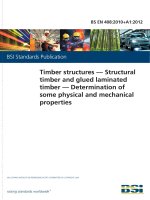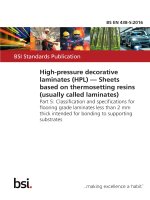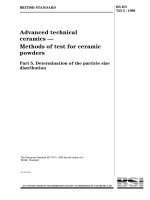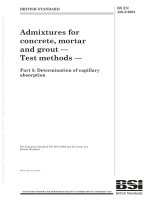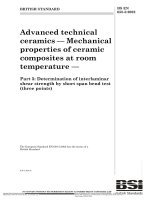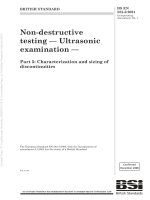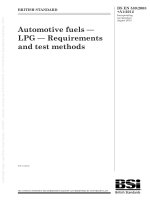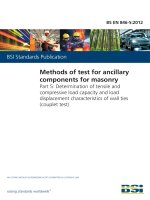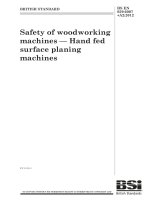Bsi bs en 61158 5 18 2012
Bạn đang xem bản rút gọn của tài liệu. Xem và tải ngay bản đầy đủ của tài liệu tại đây (1.12 MB, 40 trang )
BS EN 61158-5-18:2012
BSI Standards Publication
Industrial communication
networks — Fieldbus
specifications
Part 5-18: Application layer service
definition — Type 18 elements
BRITISH STANDARD
BS EN 61158-5-18:2012
National foreword
This British Standard is the UK implementation of EN 61158-5-18:2012. It is
identical to IEC 61158-5-18:2010. It supersedes BS EN 61158-5-18:2008
which is withdrawn.
The UK participation in its preparation was entrusted to Technical Committee
AMT/7, Industrial communications: process measurement and control,
including fieldbus.
A list of organizations represented on this committee can be obtained on
request to its secretary.
This publication does not purport to include all the necessary provisions of a
contract. Users are responsible for its correct application.
© The British Standards Institution 2012
Published by BSI Standards Limited 2012
ISBN 978 0 580 71558 7
ICS 25.040.40; 35.100.70; 35.110
Compliance with a British Standard cannot confer immunity from
legal obligations.
This British Standard was published under the authority of the Standards
Policy and Strategy Committee on 31 July 2012.
Amendments issued since publication
Date
Text affected
BS EN 61158-5-18:2012
EUROPEAN STANDARD
EN 61158-5-18
NORME EUROPÉENNE
June 2012
EUROPÄISCHE NORM
ICS 25.040.40; 35.100.70; 35.110
Supersedes EN 61158-5-18:2008
English version
Industrial communication networks Fieldbus specifications Part 5-18: Application layer service definition Type 18 elements
(IEC 61158-5-18:2010)
Réseaux de communication industriels Spécifications des bus de terrain Partie 5-18: Définition des services des
couches d'application Eléments de type 18
(CEI 61158-5-18:2010)
Industrielle Kommunikationsnetze Feldbusse Teil 5-18: Dienstfestlegungen des
Application Layer (Anwendungsschicht) Typ 18-Elemente
(IEC 61158-5-18:2010)
This European Standard was approved by CENELEC on 2012-03-28. CENELEC members are bound to comply
with the CEN/CENELEC Internal Regulations which stipulate the conditions for giving this European Standard
the status of a national standard without any alteration.
Up-to-date lists and bibliographical references concerning such national standards may be obtained on
application to the CEN-CENELEC Management Centre or to any CENELEC member.
This European Standard exists in three official versions (English, French, German). A version in any other
language made by translation under the responsibility of a CENELEC member into its own language and notified
to the CEN-CENELEC Management Centre has the same status as the official versions.
CENELEC members are the national electrotechnical committees of Austria, Belgium, Bulgaria, Croatia, Cyprus,
the Czech Republic, Denmark, Estonia, Finland, France, Germany, Greece, Hungary, Iceland, Ireland, Italy,
Latvia, Lithuania, Luxembourg, Malta, the Netherlands, Norway, Poland, Portugal, Romania, Slovakia, Slovenia,
Spain, Sweden, Switzerland, Turkey and the United Kingdom.
CENELEC
European Committee for Electrotechnical Standardization
Comité Européen de Normalisation Electrotechnique
Europäisches Komitee für Elektrotechnische Normung
Management Centre: Avenue Marnix 17, B - 1000 Brussels
© 2012 CENELEC -
All rights of exploitation in any form and by any means reserved worldwide for CENELEC members.
Ref. No. EN 61158-5-18:2012 E
BS EN 61158-5-18:2012
EN 61158-5-18:2012
-2-
Foreword
The text of document 65C/606/FDIS, future edition 2 of IEC 61158-5-18, prepared by SC 65C, "Industrial
networks", of IEC/TC 65, "Industrial-process measurement, control and automation" was submitted to the
IEC-CENELEC parallel vote and approved by CENELEC as EN 61158-5-18:2012.
The following dates are fixed:
•
•
latest date by which the document has
to be implemented at national level by
publication of an identical national
standard or by endorsement
latest date by which the national
standards conflicting with the
document have to be withdrawn
(dop)
2012-12-28
(dow)
2015-03-28
This document supersedes EN 61158-5-18:2008.
EN 61158-5-18:2012 includes the following significant technical change with respect to EN 61158-518:2008:
— editorial corrections;
— addition of cyclic data segmenting.
Attention is drawn to the possibility that some of the elements of this document may be the subject of
patent rights. CENELEC [and/or CEN] shall not be held responsible for identifying any or all such patent
rights.
Endorsement notice
The text of the International Standard IEC 61158-5-18:2010 was approved by CENELEC as a European
Standard without any modification.
In the official version, for Bibliography, the following notes have to be added for the standards indicated:
IEC 61131-1
NOTE Harmonized as EN 61131-1.
IEC 61131-3
NOTE Harmonized as EN 61131-3.
IEC 61158-3-18:2007
NOTE Harmonized as EN 61158-3-18:2008 (not modified).
IEC 61158-4-18:2010
NOTE Harmonized as EN 61158-4-18:2012 (not modified).
IEC 61158-6-18:2010
NOTE Harmonized as EN 61158-6-18:2012 (not modified).
BS EN 61158-5-18:2012
EN 61158-5-18:2012
-3-
Annex ZA
(normative)
Normative references to international publications
with their corresponding European publications
The following documents, in whole or in part, are normatively referenced in this document and are
indispensable for its application. For dated references, only the edition cited applies. For undated
references, the latest edition of the referenced document (including any amendments) applies.
NOTE When an international publication has been modified by common modifications, indicated by (mod), the relevant EN/HD
applies.
Publication
Year
Title
EN/HD
Year
IEC 60559
-
Binary floating-point arithmetic for
microprocessor systems
HD 592 S1
-
IEC/TR 61158-1
2010
Industrial communication networks - Fieldbus CLC/TR 61158-1
specifications Part 1: Overview and guidance for the
IEC 61158 and IEC 61784 series
2010
ISO/IEC 7498-1
-
Information technology - Open Systems
Interconnection - Basic Reference Model: The
Basic Model
-
ISO/IEC 8822
-
Information technology - Open Systems
Interconnection - Presentation service
definition
-
-
ISO/IEC 8824-1
-
Information technology - Abstract Syntax
Notation One (ASN.1): Specification of basic
notation
-
ISO/IEC 9545
-
Information technology - Open Systems
Interconnection - Application Layer structure
-
-
–2–
BS EN 61158-5-18:2012
61158-5-18 © IEC:2010(E)
CONTENTS
INTRODUCTION.....................................................................................................................5
1
Scope ...............................................................................................................................6
2
1.1 Overview .................................................................................................................6
1.2 Specifications ..........................................................................................................7
1.3 Conformance...........................................................................................................7
Normative references .......................................................................................................7
3
Terms, definitions, abbreviations, and conventions ........................................................... 8
4
3.1 Referenced terms and definitions ............................................................................8
3.2 Additional terms and definitions for distributed automation ...................................... 8
3.3 Abbreviations and symbols ......................................................................................9
3.4 Conventions ............................................................................................................9
Concepts ..........................................................................................................................9
5
4.1 Common concepts ...................................................................................................9
4.2 Type specific concepts ............................................................................................9
Data type ASE ................................................................................................................ 11
6
5.1 General ................................................................................................................. 11
5.2 Formal definition of data type objects .................................................................... 11
5.3 FAL defined data types.......................................................................................... 11
5.4 Data type ASE service specification ...................................................................... 14
Communication model specification ................................................................................ 14
6.1 General ................................................................................................................. 14
6.2 ASEs ..................................................................................................................... 14
6.3 ARs ....................................................................................................................... 22
Bibliography.......................................................................................................................... 36
Table 1 – AR types ............................................................................................................... 10
Table 2 – Process data support level .................................................................................... 11
Table 3 – Get Attributes service parameters ......................................................................... 15
Table 4 – Set Attributes service parameters.......................................................................... 16
Table 5 – Error indication parameters ................................................................................... 16
Table 6 – Connect service parameters .................................................................................. 17
Table 7 – Disconnect service parameters.............................................................................. 17
Table 8 – Start scan service parameters ............................................................................... 18
Table 9 – Stop scan service parameters ............................................................................... 18
Table 10 – M1 Verify slave configuration service parameters ................................................ 24
Table 11 – Stop scan service parameters ............................................................................. 25
Table 12 – M2 Verify slave configuration service parameters ................................................ 26
Table 13 – Get attributes service parameters ........................................................................ 28
Table 14 – Set attributes service parameters ........................................................................ 29
Table 15 – Error indication parameters ................................................................................. 29
BS EN 61158-5-18:2012
61158-5-18 © IEC:2010(E)
–5–
INTRODUCTION
This part of IEC 61158 is one of a series produced to facilitate the interconnection of
automation system components. It is related to other standards in the set as defined by the
“three-layer” fieldbus reference model described in IEC/TR 61158-1.
The application service is provided by the application protocol making use of the services
available from the data-link or other immediately lower layer. This standard defines the
application service characteristics that fieldbus applications and/or system management may
exploit.
Throughout the set of fieldbus standards, the term “service” refers to the abstract capability
provided by one layer of the OSI Basic Reference Model to the layer immediately above. Thus,
the application layer service defined in this standard is a conceptual architectural service,
independent of administrative and implementation divisions.
–6–
BS EN 61158-5-18:2012
61158-5-18 © IEC:2010(E)
INDUSTRIAL COMMUNICATION NETWORKS –
FIELDBUS SPECIFICATIONS –
Part 5-18: Application layer service definition –
Type 18 elements
1
1.1
Scope
Overview
The fieldbus application layer (FAL) provides user programs with a means to access the
fieldbus communication environment. In this respect, the FAL can be viewed as a “window
between corresponding application programs.”
This part of IEC 61158 provides common elements for basic time-critical and non-time-critical
messaging communications between application programs in an automation environment and
material specific to Type 18 fieldbus. The term “time-critical” is used to represent the
presence of a time-window, within which one or more specified actions are required to be
completed with some defined level of certainty. Failure to complete specified actions within
the time window risks failure of the applications requesting the actions, with attendant risk to
equipment, plant and possibly human life.
This part of IEC 61158 defines in an abstract way the externally visible service provided by
the Type 18 fieldbus application layer in terms of
a) an abstract model for defining application resources (objects) capable of being
manipulated by users via the use of the FAL service,
b) the primitive actions and events of the service;
c) the parameters associated with each primitive action and event, and the form which they
take; and
d) the interrelationship between these actions and events, and their valid sequences.
The purpose of this part of IEC 61158 is to define the services provided to
a) the FAL user at the boundary between the user and the Application Layer of the Fieldbus
Reference Model, and
b) Systems Management at the boundary between the Application Layer and Systems
Management of the Fieldbus Reference Model.
This part of IEC 61158 specifies the structure and services of the Type 18 IEC fieldbus
Application Layer, in conformance with the OSI Basic Reference Model (ISO/IEC 7498-1) and
the OSI Application Layer Structure (ISO/IEC 9545).
FAL services and protocols are provided by FAL application-entities (AE) contained within the
application processes. The FAL AE is composed of a set of object-oriented Application
Service Elements (ASEs) and a Layer Management Entity (LME) that manages the AE. The
ASEs provide communication services that operate on a set of related application process
object (APO) classes. One of the FAL ASEs is a management ASE that provides a common
set of services for the management of the instances of FAL classes.
Although these services specify, from the perspective of applications, how request and
responses are issued and delivered, they do not include a specification of what the requesting
and responding applications are to do with them. That is, the behavioral aspects of the
applications are not specified; only a definition of what requests and responses they can
BS EN 61158-5-18:2012
61158-5-18 © IEC:2010(E)
–7–
send/receive is specified. This permits greater flexibility to the FAL users in standardizing
such object behavior. In addition to these services, some supporting services are also defined
in this standard to provide access to the FAL to control certain aspects of its operation.
1.2
Specifications
The principal objective of this part of IEC 61158 is to specify the characteristics of conceptual
application layer services suitable for time-critical communications, and thus supplement the
OSI Basic Reference Model in guiding the development of application layer protocols for timecritical communications.
A secondary objective is to provide migration paths from previously-existing industrial
communications protocols. It is this latter objective which gives rise to the diversity of services
standardized as the various Types of IEC 61158, and the corresponding protocols
standardized in subparts of IEC 61158-6.
This specification may be used as the basis for formal Application Programming-Interfaces.
Nevertheless, it is not a formal programming interface, and any such interface will need to
address implementation issues not covered by this specification, including
a) the sizes and octet ordering of various multi-octet service parameters, and
b) the correlation of paired request and confirm, or indication and response, primitives.
1.3
Conformance
This part of IEC 61158 does not specify individual implementations or products, nor do they
constrain the implementations of application layer entities within industrial automation
systems.
There is no conformance of equipment to this application layer service definition standard.
Instead, conformance is achieved through implementation of conforming application layer
protocols that fulfill the Type 18 application layer services as defined in this part of IEC 61158.
2 Normative references
The following referenced documents are indispensable for the application of this document.
For dated references, only the edition cited applies. For undated references, the latest edition
of the referenced document (including any amendments) applies.
IEC 60559, Binary floating-point arithmetic for microprocessor systems
IEC/TR 61158-1:2010 1, Industrial communication networks – Fieldbus specifications – Part
Overview and guidance for the IEC 61158 and IEC 61784 series
1:
ISO/IEC 7498-1, Information technology – Open Systems Interconnection – Basic Reference
Model: The Basic Model
ISO/IEC 8822, Information technology – Open Systems Interconnection – Presentation
service definition
ISO/IEC 8824-1, Information
Specification of basic notation
___________
1
To be published
technology
–
Abstract
Syntax
Notation
One
(ASN.1):
–8–
BS EN 61158-5-18:2012
61158-5-18 © IEC:2010(E)
ISO/IEC 9545, Information technology – Open Systems Interconnection – Application Layer
structure
3
Terms, definitions, abbreviations, and conventions
3.1
Referenced terms and definitions
3.1.1
ISO/IEC 7498-1 terms
For the purposes of this document, the following terms as defined in ISO/IEC 7498-1 apply:
a) application entity
b) application process
c) application protocol data unit
d) application service element
e) application entity invocation
f)
application process invocation
g) application transaction
h) real open system
i)
transfer syntax
3.1.2
ISO/IEC 8822 terms
For the purposes of this document, the following terms as defined in ISO/IEC 8822 apply:
a) abstract syntax
b) presentation context
3.1.3
ISO/IEC 9545 terms
For the purposes of this document, the following terms as defined in ISO/IEC 9545 apply:
a) application-association
b) application-context
c) application context name
d) application-entity-invocation
e) application-entity-type
f)
application-process-invocation
g) application-process-type
h) application-service-element
i)
application control service element
3.1.4
ISO/IEC 8824-1 terms
For the purposes of this document, the following terms as defined in ISO/IEC 8824-1 apply:
a) object identifier
b) type
3.2
Additional terms and definitions for distributed automation
For the purposes of this document, the following terms and definitions apply.
BS EN 61158-5-18:2012
61158-5-18 © IEC:2010(E)
–9–
3.2.1
Register X
register containing bit-oriented cyclic data of type input data that is transmitted from a slave to
a master
3.2.2
Register Y
register containing bit-oriented cyclic data of type output data that is transmitted from a
master to a slave
3.2.3
Register Wr
register containing word-oriented cyclic data of type input data that is transmitted from a slave
to a master
3.2.4
Register Ww
register containing word-oriented cyclic data of type output data that is transmitted from a
master to a slave
3.3
Abbreviations and symbols
RX
Register X
RY
Register Y
RWr
Register Wr
RWw
Register Ww
3.4
Conventions
There are no conventions defined specific to Type 18 FAL.
4
Concepts
4.1
Common concepts
IEC/TR 61158-1:2010, Clause 9 describes the concepts of the application layer service
descriptions and the templates used in this document, except as specifically overridden in 4.2.
4.2
4.2.1
Type specific concepts
Overview
Described in this communication model specification are the Application Service Elements
(ASE) and the Application Process (AP) object class models. The syntax and related encoding
of attributes is described by the Type 18 Application layer protocol specification.
The Type 18 AL identifies two types of FAL user, master and slave. For each FAL user type
there are two classes of Data Link Entity (DLE), Class 1 and Class 2, corresponding to the
Polled and Packed class of the DLE, respectively. See appropriate definitions and
specifications in the Type 18 Data link for more information about the Polled and Packed
class of DLE. Therefore, there are 4 types of Application Relationship (AR) as shown in
Table 1.
BS EN 61158-5-18:2012
61158-5-18 © IEC:2010(E)
– 10 –
Table 1 – AR types
AR class
Symbol
FAL user type
DLE class
Master Class 1
M1
Master
Polled
Master Class 2
M2
Master
Packed
Slave Class 1
S1
Slave
Polled
Slave Class 2
S2
Slave
Packed
An Application Process (AP) object model consists of
•
one Device Manager object,
•
one Connection Manager object, and
•
one or more Process Data objects.
The specific classes of objects included depend upon the type of device and are identified by
prefixes that match the symbol of the related AR class.
4.2.2
Stations and slots
Each device and its corresponding FAL is identified by a number. This identifying number is
named the Station number. The station number is the address used to identify the device and
the AR End Point (AREP) associated with the transmission and reception of its process data.
Cyclic process data is further addressed by slot number. One slot is the granularity of the
position dependent mapping of the cyclic data fields. A station may occupy more than one
slot. The slots belonging to an AREP are identified by the range of slots beginning with the
station number and with a length equal to the number of occupied slots as configured by the
FAL user.
4.2.3
Transmission methods
The Type 18 AL implements a master/slave type architecture. Only a master is able to initiate
transmissions. Slave devices respond to transmissions from the master. The access method
employed is scanning. A scan cycle is one where the master device transmits data to, and
receives data from, all the slaves connected to it. The particulars of the transmission
methods are described by the Type 18 Application layer protocol specification.
4.2.4
Process data structures
Symbols (RX, RY, RWr, and RWw) are used throughout the Type 18 specifications to refer to
types of cyclic data registers which are used to buffer process data for transmission and
reception.
In addition to cyclic data, some AR types support acyclic message transmissions, sometimes
named transient data transmissions by some industry users.
The type of data supported by an FAL is indicated by the level of process data support which
is specified with the nomenclature described in Table 2.
BS EN 61158-5-18:2012
61158-5-18 © IEC:2010(E)
– 11 –
Table 2 – Process data support level
5
Process data
support level
Data type supported
Type 18 industry users
Alias terminology
A
bit-oriented i/o data
Remote i/o station
B
A + word-oriented i.o data
Remote device station
C
B + acyclic messaging
Intelligent device station
Data type ASE
5.1
General
An overview of the data type ASE and the relationships between data types is provided in
IEC/TR 61158-1:2010, 10.1.
5.2
Formal definition of data type objects
The template used to describe the data type class in this clause is detailed in
IEC/TR 61158-1:2010, 10.2. This includes the specific ASE structure and the definition of its
attributes.
5.3
FAL defined data types
5.3.1
5.3.1.1
5.3.1.1.1
Fixed length types
Boolean types
Boolean
CLASS:
Data type
ATTRIBUTES:
1
Data type Numeric Identifier = 1
2
Data type Name
= Boolean
3
Format
= FIXED LENGTH
4.1
Octet Length
= 1
This data type expresses a Boolean data type with the values TRUE and FALSE.
5.3.1.2
5.3.1.2.1
Bitstring types
BitString8
CLASS:
Data type
ATTRIBUTES:
1
Data type Numeric Identifier = 22
2
Data type Name
= Bitstring8
3
Format
= FIXED LENGTH
5.1
Octet Length
= 1
5.3.1.2.2
Octet
This data type is the same as Bitstring8.
5.3.1.2.3
BitString16
CLASS:
Data type
ATTRIBUTES:
1
Data type Numeric Identifier = 23
2
Data type Name
= Bitstring16
3
Format
= FIXED LENGTH
5.1
Octet Length
= 2
– 12 –
5.3.1.2.4
BS EN 61158-5-18:2012
61158-5-18 © IEC:2010(E)
Word
This data type is the same as Bitstring16.
5.3.1.2.5
BitString32
CLASS:
Data type
ATTRIBUTES:
1
Data type Numeric Identifier = 24
2
Data type Name
= Bitstring32
3
Format
= FIXED LENGTH
5.1
Octet Length
= 4
5.3.1.3
5.3.1.3.1
5.3.1.3.1.1
Numeric types
Floating Point types
Float32
CLASS:
Data type
ATTRIBUTES:
1
Data type Numeric Identifier = 8
2
Data type Name
= Float32
4
Format
= FIXED LENGTH
4.1
Octet Length
= 4
This type has a length of four octets. The format for Float32 is that defined by IEC 60559 as
single precision.
5.3.1.3.1.2
float
This data type is the same as Float32.
5.3.1.3.1.3
Float64
CLASS:
Data type
ATTRIBUTES:
1
Data type Numeric Identifier = 15
2
Data type Name
= Float64
3
Format
= FIXED LENGTH
4.1
Octet Length
= 8
This type has a length of eight octets. The format for Float64 is that defined by IEC 60559 as
double precision.
5.3.1.3.1.4
double
This data type is the same as Float64.
5.3.1.3.2
5.3.1.3.2.1
Integer types
Integer8
CLASS:
Data type
ATTRIBUTES:
1
Data type Numeric Identifier = 2
2
Data type Name
= Integer8
3
Format
= FIXED LENGTH
4.1
Octet Length
= 1
This integer type is a two’s complement binary number with a length of one octet.
5.3.1.3.2.2
char
This data type is the same as Integer8.
BS EN 61158-5-18:2012
61158-5-18 © IEC:2010(E)
5.3.1.3.2.3
– 13 –
Integer16
CLASS:
Data type
ATTRIBUTES:
1
Data type Numeric Identifier = 3
2
Data type Name
= Integer16
3
Format
= FIXED LENGTH
4.1
Octet Length
= 2
This integer type is a two’s complement binary number with a length of two octets.
5.3.1.3.2.4
short
This data type is the same as Integer16.
5.3.1.3.2.5
Integer32
CLASS:
Data type
ATTRIBUTES:
1
Data type Numeric Identifier = 4
2
Data type Name
= Integer32
3
Format
= FIXED LENGTH
4.1
Octet Length
= 4
This integer type is a two’s complement binary number with a length of four octets.
5.3.1.3.2.6
long
This data type is the same as Integer32.
5.3.1.3.3
5.3.1.3.3.1
Unsigned types
Unsigned8
CLASS:
Data type
ATTRIBUTES:
1
Data type Numeric Identifier
= 5
2
Data type Name
= Unsigned8
3
Format
= FIXED LENGTH
4.1
Octet Length
= 1
This type is a binary number. The most significant bit of the most significant octet is always
used as the most significant bit of the binary number; no sign bit is included. This type has a
length of one octet.
5.3.1.3.3.2
unsigned char
This data type is the same as Unsigned8.
5.3.1.3.3.3
Unsigned16
CLASS:
Data type
ATTRIBUTES:
1
Data type Numeric Identifier
= 6
2
Data type Name
= Unsigned16
3
Format
= FIXED LENGTH
4.1
Octet Length
= 2
This type is a binary number. The most significant bit of the most significant octet is always
used as the most significant bit of the binary number; no sign bit is included. This unsigned
type has a length of two octets.
5.3.1.3.3.4
unsigned short
This data type is the same as Unsigned16.
– 14 –
5.3.1.3.3.5
BS EN 61158-5-18:2012
61158-5-18 © IEC:2010(E)
Unsigned32
CLASS:
Data type
ATTRIBUTES:
1
Data type Numeric Identifier
= 7
2
Data type Name
= Unsigned32
3
Format
= FIXED LENGTH
4.1
Octet Length
= 4
This type is a binary number. The most significant bit of the most significant octet is always
used as the most significant bit of the binary number; no sign bit is included. This unsigned
type has a length of four octets.
5.3.1.3.3.6
unsigned long
This data type is the same as Unsigned32.
5.4
Data type ASE service specification
There are no operational services defined for the type object.
6
Communication model specification
6.1
General
The Type 18 AL describes a master/slave type architecture with master transmission methods
employed to transfer process data between the master device and its connected slave
devices.
6.2
ASEs
6.2.1
6.2.1.1
Management ASE
Overview
The management ASE manages the FAL components related to the type of device in which
the FAL is implemented.
6.2.1.2
6.2.1.2.1
Management class specification
Formal model
FAL ASE:
CLASS:
CLASS ID:
PARENT CLASS:
SERVICES:
1.
(m) OpsService:
2.
(o)
OpsService:
3.
(o)
OpsService:
4.
(c)
Constraint:
4.1.
(m) OpsService:
4.2.
(m) OpsService:
5.
(c)
Constraint:
5.3.
(m) OpsService:
5.4.
(m) OpsService:
6.2.1.2.2
Management ASE
Manager
not used
TOP
Get
Set
Error
object class = M1/M2/S1/S2 Connection Manager
Connect
Disconnect
object class = M1/M2 Connection Manager
Start scan
Stop scan
Attributes
There are no attributes defined for this ASE.
BS EN 61158-5-18:2012
61158-5-18 © IEC:2010(E)
6.2.1.2.3
– 15 –
Services
Get
This service is used to read attribute values.
Set
This service is used to write attribute values.
Error
This indication is used to communicate error events.
Connect
This service is used to connect to the network.
Disconnect
This service is used to disconnect to the network.
Start scan
This service is used to initiate the master scanning.
Stop scan
This service is used to terminate the master scanning.
6.2.1.3
6.2.1.3.1
6.2.1.3.1.1
Management ASE service specifications
Get service
Service overview
This service is used to read attribute values.
6.2.1.3.1.2
Service primitives
The parameters for the Get service are listed in Table 3.
Table 3 – Get Attributes service parameters
Parameter name
Rsp
Cnf
Response code
M
M (=)
Attribute value
M
M (=)
Requested attribute
Req
Ind
M
M (=)
NOTE The method by which a confirm primitive is correlated with its
corresponding preceding request primitive is a local matter. See 1.2.
Requested attribute
This parameter specifies the identity of the attribute whose value is being requested.
Response code
This parameter specifies the classification of the response as either successful or an error
code.
Attribute value
This parameter specifies the value of the requested attribute if successful. The format of the
parameter is that of the attribute requested.
6.2.1.3.1.3
Service procedure
The service request results in a returned value or an error code.
BS EN 61158-5-18:2012
61158-5-18 © IEC:2010(E)
– 16 –
6.2.1.3.2
6.2.1.3.2.1
Set service
Service overview
This service is used to write attribute values.
6.2.1.3.2.2
Service primitives
The parameters for the Set service are listed in Table 4.
Table 4 – Set Attributes service parameters
Parameter name
Req
Ind
Requested attribute
M
M (=)
Attribute value
M
M (=)
Rsp
Cnf
M
M (=)
Response code
NOTE The method by which a confirm primitive is correlated with its
corresponding preceding request primitive is a local matter. See 1.2.
Requested attribute
This parameter specifies the identity of the attribute whose value is being set.
Attribute value
This parameter specifies the value to which the attribute is to be set.
parameter is that of the attribute being set.
The format of the
Response code
This parameter specifies the classification of the response as either successful or an error
code.
6.2.1.3.2.3
Service procedure
The service request results in an attribute value being set or an error code.
6.2.1.3.3
6.2.1.3.3.1
Error indication
Service overview
This indication is used to communicate error events.
6.2.1.3.3.2
Service primitives
The parameters for the Error indication are listed in Table 5.
Table 5 – Error indication parameters
Parameter name
Error code
Ind
M
Error code
This parameter specifies the classification of the error.
6.2.1.3.3.3
Service procedure
The FAL user is notified of an error with the accompanying code.
BS EN 61158-5-18:2012
61158-5-18 © IEC:2010(E)
6.2.1.3.4
6.2.1.3.4.1
– 17 –
Connect service
Service overview
This service is used to connect to the network.
6.2.1.3.4.2
Service primitives
The parameters for the Connect service are listed in Table 6.
Table 6 – Connect service parameters
Parameter name
Req
Response code
Cnf
M
NOTE The method by which a confirm primitive is
correlated with its corresponding preceding request
primitive is a local matter. See 1.2.
Response code
This parameter specifies the classification of the response as either successful or an error
code.
6.2.1.3.4.3
Service procedure
The Connect service request invokes an appropriate series of DL service requests through
the AP protocol in order to establish the specified AR.
For Connection Manger objects belonging to the master class, this service provides the FAL
user with connection to, and identification of, one or more slaves to which it has access.
For Connection Manger objects belonging to the slave class, this service provides the FAL
user with connection to, and identification of, its associated master and begins the behavior
associated with the slave class scanning of process data.
6.2.1.3.5
6.2.1.3.5.1
Disconnect service
Service overview
This service is used to disconnect from the network.
6.2.1.3.5.2
Service primitives
The parameters for the Disconnect service are listed in Table 7.
Table 7 – Disconnect service parameters
Parameter name
Response code
Req
Cnf
M
NOTE The method by which a confirm primitive is correlated with its
corresponding preceding request primitive is a local matter. See 1.2.
Response code
This parameter specifies the classification of the response as either successful or an error
code.
BS EN 61158-5-18:2012
61158-5-18 © IEC:2010(E)
– 18 –
6.2.1.3.5.3
Service procedure
The Disconnect service request invokes an appropriate series of DL service requests through
the AP protocol in order to terminate a previously established AR.
6.2.1.3.6
6.2.1.3.6.1
Start scan service
Service overview
This service is used to initiate the master scanning.
6.2.1.3.6.2
Service primitives
The parameters for the Start scan service are listed in Table 8.
Table 8 – Start scan service parameters
Parameter name
Req
Ind
Response code
Rsp
Cnf
M
M (=)
NOTE The method by which a confirm primitive is correlated with its
corresponding preceding request primitive is a local matter. See 1.2.
Response code
This parameter specifies the classification of the response as either successful or an error
code.
6.2.1.3.6.3
Service procedure
The Start scan service request invokes an appropriate series of DL service requests through
the AP protocol in order to begin the behavior associated with the scanning of process data.
6.2.1.3.7
6.2.1.3.7.1
Stop scan service
Service overview
This service is used to terminate the master scanning.
6.2.1.3.7.2
Service primitives
The parameters for the Stop scan service are listed in Table 9.
Table 9 – Stop scan service parameters
Parameter name
Response code
Req
Ind
Rsp
Cnf
M
M (=)
NOTE The method by which a confirm primitive is correlated with its
corresponding preceding request primitive is a local matter. See 1.2.
Response code
This parameter specifies the classification of the response as either successful or an error
code.
6.2.1.3.7.3
Service procedure
The Stop scan service request invokes an appropriate series of DL service requests through
the AP protocol in order to terminate a previously started scan behavior.
BS EN 61158-5-18:2012
61158-5-18 © IEC:2010(E)
6.2.1.4
6.2.1.4.1
– 19 –
M1 device manager class specification
Formal model
The M1 device manager class supports a master type FAL user on a Polled type DL
implementation.
FAL ASE:
CLASS:
CLASS ID:
PARENT CLASS:
ATTRIBUTES:
1
(m) Attribute:
1.1
(m) Attribute:
1.2
(m) Attribute:
1.3
(m) Attribute:
1.3.1
(m) Attribute:
1.3.2
(m) Attribute:
1.3.3
(m) Attribute:
1.3.4
(o)
Attribute:
2
(m) Attribute:
2.1
(m) Attribute:
2.1.1
(m) Attribute:
2.1.2
(m) Attribute:
2.1.3
(m) Attribute:
2.1.4
(o)
Attribute:
2.1.5
(m) Attribute:
…
…
…
2.n
(m) Attribute:
2.n.1
(m) Attribute:
2.n.2
(m) Attribute:
2.n.3
(m) Attribute:
2.n.4
(o)
Attribute:
2.n.5
(m) Attribute:
…
…
…
2.64
(m) Attribute:
2.64.1 (m) Attribute:
2.64.2 (m) Attribute:
2.64.3 (m) Attribute:
2.64.4 (o)
Attribute:
2.64.5 (m) Attribute:
6.2.1.4.2
Management ASE
M1 device manager
not used
Manager
Management information
Transmission speed
Number of occupied stations
Device information
Station number
Vendor code
Model code
Software/protocol version
Connected slaves management information
Slave information 1
Station number
Vendor code
Model code
Software/protocol version
Reserved field
…
Slave information n
Station number
Vendor code
Model code
Software/protocol version
Reserved field
…
Slave information 64
Station number
Vendor code
Model code
Software/protocol version
Reserved field
Attributes
Management information
This attribute is a description of the master’s configuration; structure of:
Transmission speed
This element specifies the baud rate for the DL configuration.
Number of occupied stations
This element specifies the number of stations occupied.
Station number
This element specifies the station number for the DL configuration.
Vendor code
This element contains a unique code to identify the manufacturer of the device. Vendor code
assignment and management is beyond the scope of this specification.
Model code
This element specifies the type of device.
Software/protocol version
This element specifies the software and protocol versions of the device.
– 20 –
BS EN 61158-5-18:2012
61158-5-18 © IEC:2010(E)
Connected slaves management information
This attribute contains a description of the configuration of all connected slaves; array of 64
structures:
Slave information n
This element is a description of the configuration of slave n; structure of:
Station number
This element specifies the station number for the DL configuration.
Vendor code
This element contains a unique code to identify the manufacturer of the device. Vendor code
assignment and management is beyond the scope of this specification.
Model code
This element specifies the type of device.
Software/protocol version
This element specifies the software and protocol versions of the device.
Reserved field
This is a reserved field for future definition.
6.2.1.4.3
Services
There are no additional services defined for this class.
6.2.1.5
6.2.1.5.1
M2 device manager class specification
Formal model
The M2 device manager class supports a master type FAL user on a Packed type DL
implementation.
FAL ASE:
CLASS:
CLASS ID:
PARENT CLASS:
ATTRIBUTES:
1
(m) Attribute:
1.1
(m) Attribute:
…
…
…
1.n
(m) Attribute:
…
…
…
1.64
(m) Attribute:
2
(m) Attribute:
2.1
(m) Attribute:
…
…
…
2.n
(m) Attribute:
…
…
…
2.64
(m) Attribute:
6.2.1.5.2
Management ASE
M2 device manager
not used
Manager
Slave
Slave
…
Slave
…
Slave
Slave
Slave
…
Slave
…
Slave
station information
station information 1
station information n
station information 64
station status information
station status information 1
station status information n
station status information 64
Attributes
Slave station information
This attribute specifies a list of slave station information words collected from each connected
slave; array of 64 words:
Slave station information n
This element specifies the configuration of the referenced slave device.
Slave station status information
This attribute specifies a list of slave station status information fields collected from each
connected slave; array of 64, 4-bit elements:
BS EN 61158-5-18:2012
61158-5-18 © IEC:2010(E)
– 21 –
Slave station status information n
This element specifies the status of the referenced slave device.
6.2.1.5.3
Services
There are no additional services defined for this class.
6.2.1.6
6.2.1.6.1
S1 device manager class specification
Formal model
The S1 device manager class supports a slave type FAL user on a Polled type DL
implementation.
FAL ASE:
CLASS:
CLASS ID:
PARENT CLASS:
ATTRIBUTES:
1
(m) Attribute:
1.1
(m) Attribute:
1.2
(m) Attribute:
1.3
(m) Attribute:
1.4
(o)
Attribute:
1.5
(m) Attribute:
6.2.1.6.2
Management ASE
S1 device manager
not used
Manager
Management information
Station number
Vendor code
Model code
Software/protocol version
Reserved field
Attributes
Management information
This attribute specifies a description of the slave’s configuration; structure of
Station number
This element specifies the station number for the DL configuration.
Vendor code
This element contains a unique code to identify the manufacturer of the device. Vendor code
assignment and management is beyond the scope of this specification.
Model code
This element specifies the type of device.
Software/protocol version
This element specifies the software and protocol versions of the device.
Reserved field
This is a reserved field for future definition.
6.2.1.6.3
Services
There are no additional services defined for this class.
6.2.1.7
6.2.1.7.1
S2 device manager class specification
Formal model
The S2 device manager class supports a slave type AL-user on a Packed type DL
implementation.
FAL ASE:
CLASS:
CLASS ID:
PARENT CLASS:
ATTRIBUTES:
1
(m) Attribute:
Management ASE
S2 device manager
not used
Manager
Slave station information
– 22 –
2
(m)
6.2.1.7.2
Attribute:
BS EN 61158-5-18:2012
61158-5-18 © IEC:2010(E)
Slave station status information
Attributes
Slave station information
This attribute specifies the configuration of the slave device.
Slave station status information
This attribute specifies the status of the slave device.
6.2.1.7.3
Services
There are no additional services defined for this class.
6.3
ARs
6.3.1
Overview
The Type 18 AR uses buffered transport for process data inputs and outputs. Transmission
triggering type services are required depending upon the configuration of the instantiated
objects.
6.3.2
6.3.2.1
6.3.2.1.1
Connection management
M1 connection manager class
Formal model
The M1 connection manager class supports a master type FAL user on a Polled type DL
implementation.
The Process data support level for the M1 connection manager class is Level C.
FAL ASE:
CLASS:
CLASS ID:
PARENT CLASS:
ATTRIBUTES:
1
(m) Attribute:
1.1
(m) Attribute:
1.2
(m) Attribute:
1.3
(m) Attribute:
1.4
(m) Attribute:
1.5
(m) Attribute:
1.6
(m) Attribute:
1.7
(o)
Attribute:
1.8
(o)
Attribute:
1.9
(o)
Attribute:
1.10
(o)
Attribute:
1.11
(o)
Attribute:
1.12
(o)
Attribute:
1.13
(o)
Attribute:
1.14
(o)
Attribute:
2
(m) Attribute:
2.1
(m) Attribute:
2.2
(m) Attribute:
2.2.1
(m) Attribute:
…
…
…
2.2.n
(m) Attribute:
…
…
…
2.2.64 (m) Attribute:
2.3
(m) Attribute:
2.4
(m) Attribute:
2.4.1
(m) Attribute:
…
…
…
2.4.n
(m) Attribute:
Management ASE
M1 connection manager
not used
Manager
Parameter information
Number of connected modules
Number of intelligent devices
Station information
Number of automatic return modules
Number of retries
Delay time setting
Standby master station specification
Operation during master error state
Data link during master error state
Scan mode specification
Reserved station specification
Error invalid station specification
Reserved 1
Reserved 2
Network status information
Master status information
Slave status information
Slave status information 1
…
Slave status information n
…
Slave status information 64
Master transmitted status field
Slave transmitted status field
Slave transmitted status field 1
…
Slave transmitted status field n
BS EN 61158-5-18:2012
61158-5-18 © IEC:2010(E)
– 23 –
…
…
2.4.64 (m)
3
(m)
3.1
(m)
3.2
(m)
3.3
(m)
SERVICES:
1.
(o)
2.
(c)
2.1.
(m)
…
Attribute:
Attribute:
Attribute:
Attribute:
Attribute:
…
Slave transmitted status field 64
Network information
Current link scan time
Minimum link scan time
Maximum link scan time
OpsService:
Constraint:
OpsService:
Verify slave configuration
Master type = standby
Activate standby
6.3.2.1.2
Attributes
Parameter information
This attribute is a structure of:
Number of connected modules
This element specifies the number of slave stations connected to the master.
Number of intelligent devices
This element specifies the number of local stations and intelligent device stations connected.
Station information
This element specifies the station type and number of occupied slots.
Number of automatic return modules
This element specifies the number of slave stations that can be returned to the system within
one link scan.
Number of retries
This element specifies the retry count for communication errors.
Delay time setting
This element specifies the link scan interval.
Standby master station specification
This element specifies the station number for the standby master station.
Operation during master error state
This element specifies the data link status when an error occurs in the master as STOP or
CONTINUE the data link.
Data link during master error state
This element specifies the state for process data when an error occurs in communications as
HOLD or CLEAR the input/output data.
Scan mode specification
This element specifies the link scan to be either free-running (continuous loop) or triggered
transmission (loop once).
Reserved station specification
This element specifies the reserved station numbers. Although reserved stations are counted
as connected stations, a data link error will not occur for reserved stations not connected.
Error invalid station specification
This element specifies the error invalid slave station numbers. Slave station errors (at the
master) will not occur for error invalid slave stations.
Reserved 1
This element is a reserved field for future use by the master.
Reserved 2
This element is a reserved field for future use by the connected slaves.
